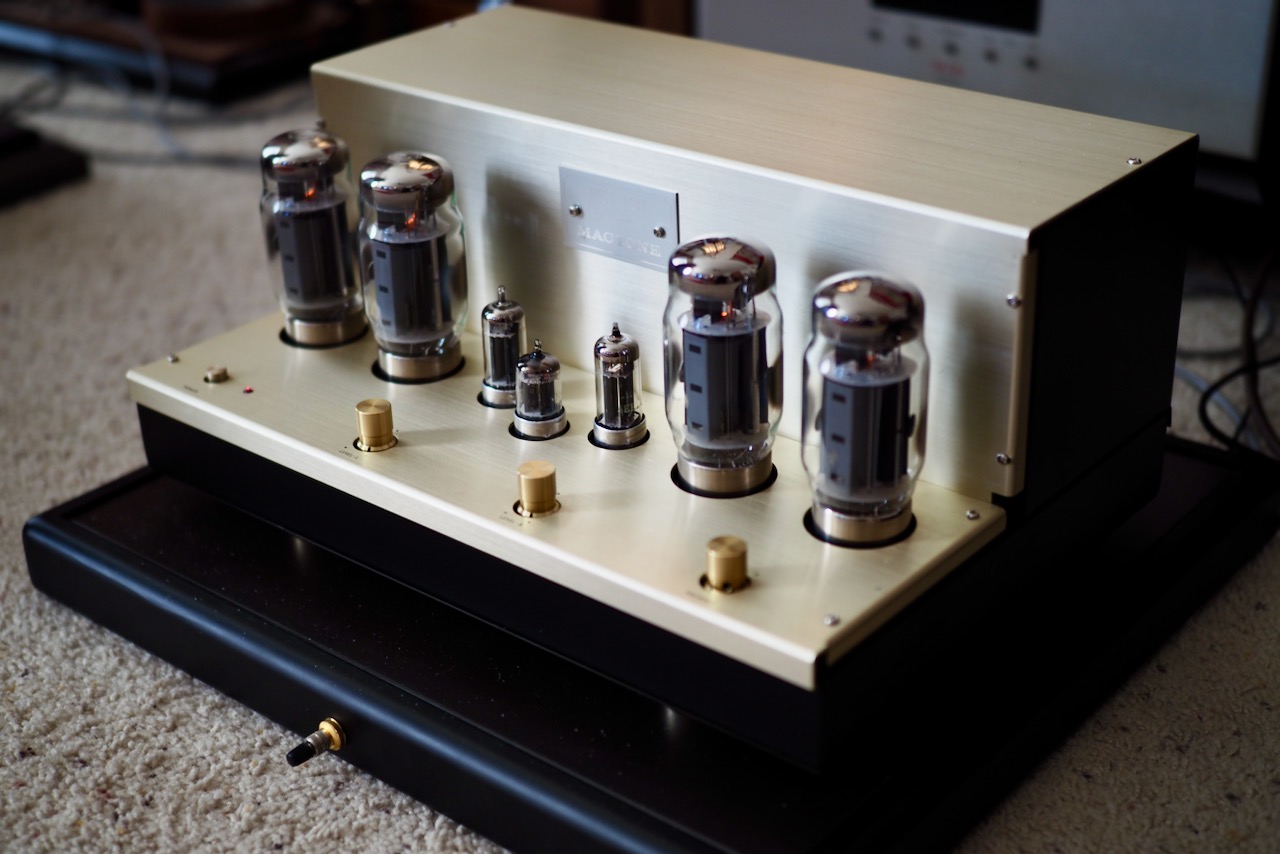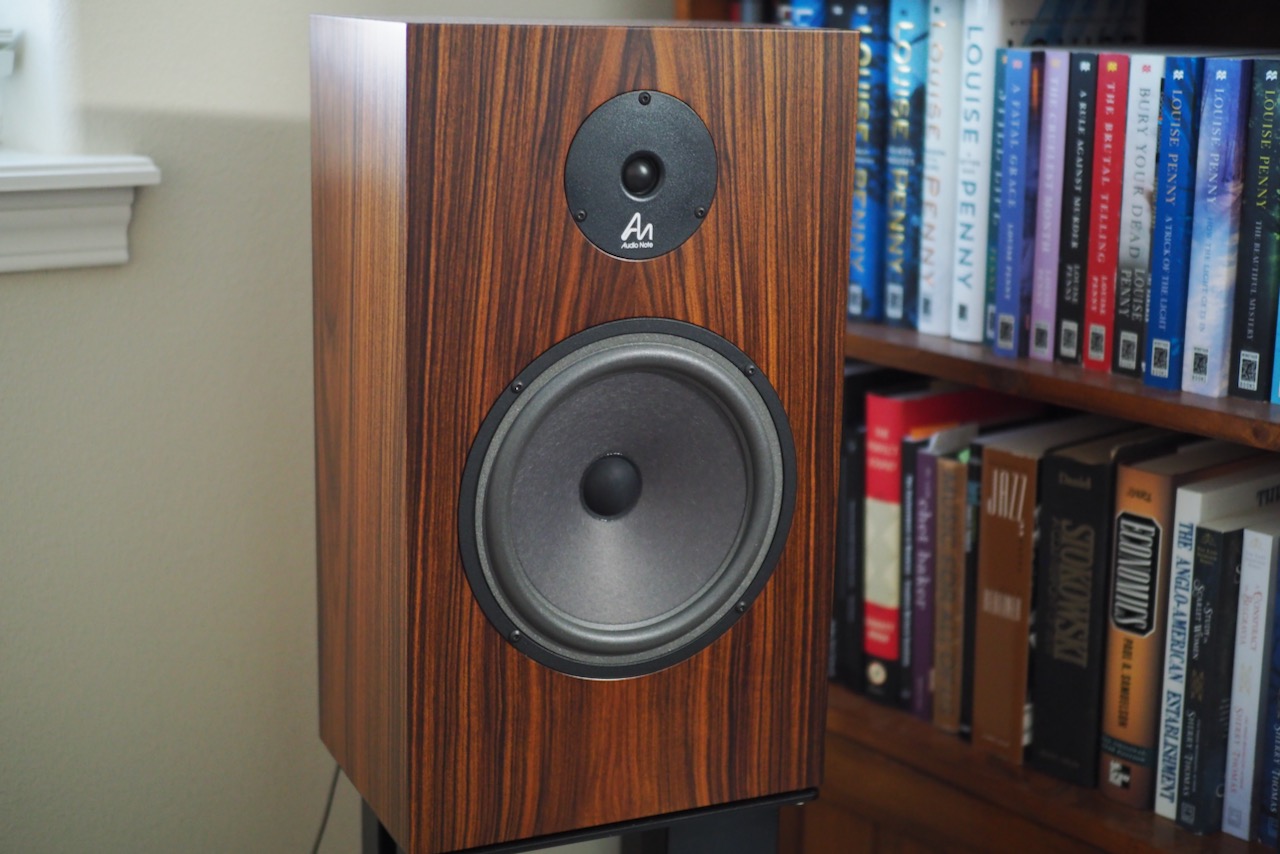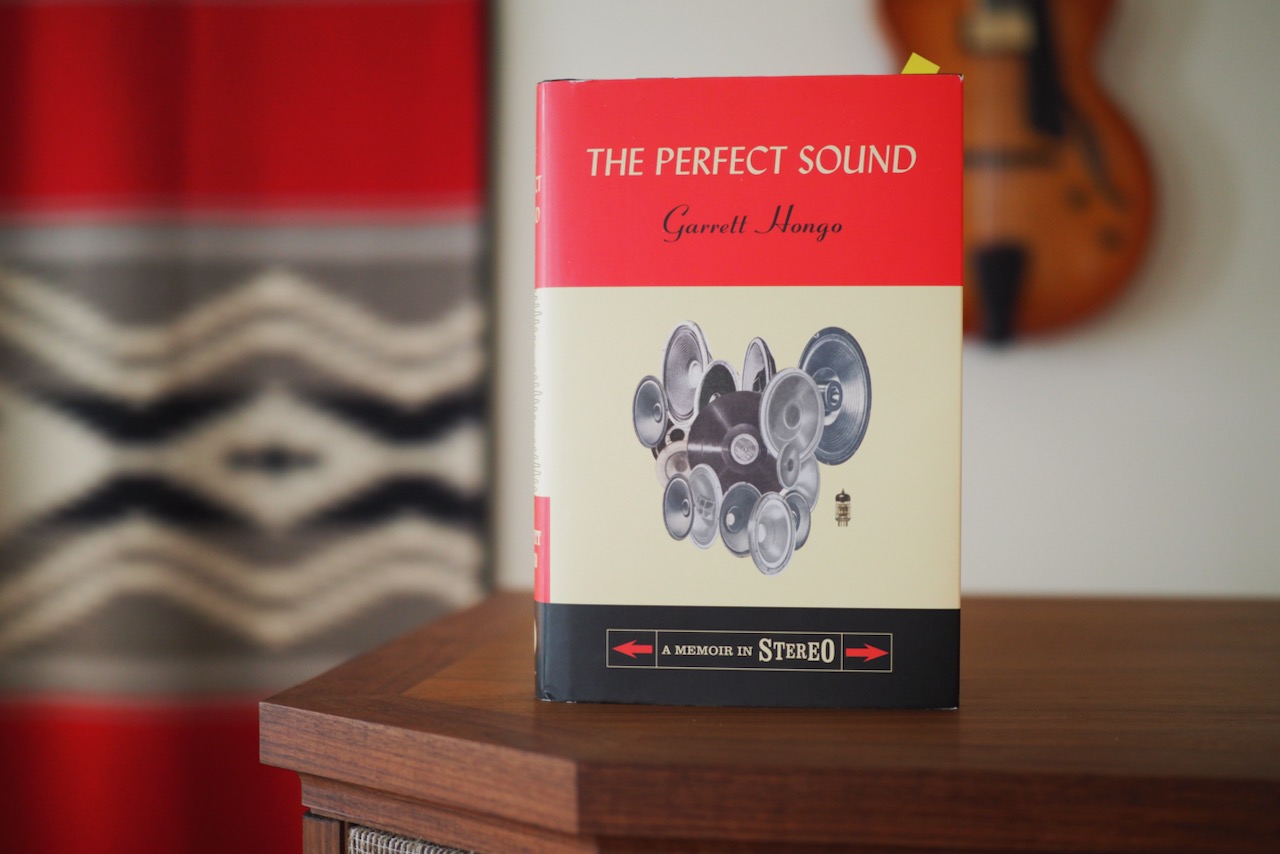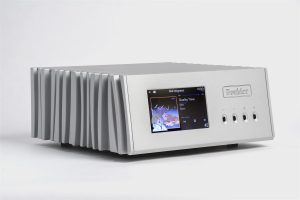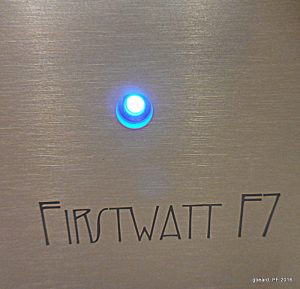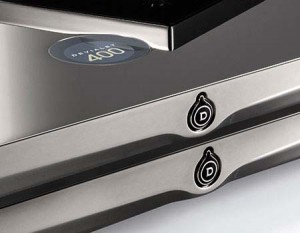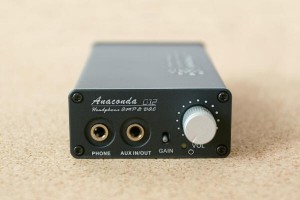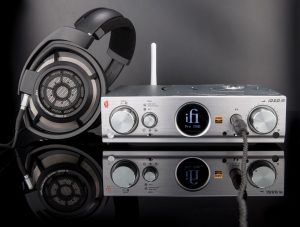Simply speaking, the output stage of the SIT-3 is a push-pull depletion/enhancement mode follower (DEF) which delivers about twice the output current of the single-ended SIT-1 and SIT-2 amplifiers.
Here's a circuit schematic of the First Watt SIT-3 stereo amplifier:
Image courtesy of Nelson Pass.
About it Nelson says, "You can see the input JFET followers driving the auto-former, which develops voltage gain for the power output followers. Besides the unusual DEF / SIT output stage, you might notice the inverted power supply, which dramatically reduces supply noise seen by the SIT. This design requires careful selection of the characteristics of each SIT matched to the MOSFET—their gate voltages must be carefully matched, and fortunately this SIT device falls into the range where such matching is possible. The actual circuit is hardly more complicated and includes a few new tricks to get both the purest square-law performance with solid stability."
Photograph by Dr. David W. Robinson, copyright (c) 2018, all rights reserved.
I should mention that Nelson is very proud of the First Watt SIT-3 and how it turned out, and he says, "This is one of those all-night, year-after-year pieces." Note the First Watt SIT-3 in Nelson's home listening room in the photo above.
Review systems
Nelson's description of First Watt's target listeners is, "If you have efficient loudspeakers, listen at reasonable levels and are obsessed about subjective performance, then you probably have come to the right place. If you want reliable audio product, then you really have come to the right place."
When I read Nelson's description of First Watt's target listeners I thought "Hey that sounds a lot like me!", as my Tannoy Westminster Royal SE, vintage Altec 832A Corona, vintage Altec A7 Voice of the Theatre, and vintage Altec A5 Voice of the Theatre loudspeakers are all hovering around the 100dB sensitivity range with 1 watt at 1 meter.
For this review of the First Watt SIT-3 stereo amplifier I used three different hifi systems in order to offer a broader context of insights into its musical & sonic performance than one system could provide, and admittedly to just have some extra audio and musical fun in three very different audio systems!
The first audio system is built around a pair of Tannoy Westminster Royal SE loudspeakers in my main listening / living room …
… the second audio system is built around a vintage pair of domestic Altec Corona 832A loudspeakers in my bedroom system (shown in the living room system in the photo above) …
… and the third system is built around a pair of vintage professional Altec A5 Voice of the Theatre loudspeakers in my audio-visual system.
The details of those systems are described in their respective listening impressions sections.
Listening Evaluations
Before I delve into my listening impressions with the First Watt SIT-3 stereo amplifier on the above three systems, allow me to provide a brief overview of what I listen for when I evaluate component performance during reviews, to help give you some additional context.
I find it useful to partition my perceptions into two broad (and somewhat overlapping) categories while listening: musicality and sonics.
The musicality aspect of a component's performance is related to its performance on the basic elements of music. I listen for how close a component comes to presenting recorded music realistically compared to live music, in terms of timbral realism (the unique 'voices' of instruments), the resolution of tone color (the ability to distinctly hear the chordal variations resulting from adding additional pitches to three tone triads), melody (the tune you 'whistle while you work'), harmony (treble & bass accompaniments to the melody), rhythm (the steady beat that determines the tempo), tempo (speed), dynamics (variations in loudness), and loudness (the ability to play naturally at live-like levels appropriate to a piece of music).
The second category of performance I listen for is sonics, a term I use to describe the performance of a component in reproducing the non-musical artifacts of the recording process, like transparency (the ability to 'see' into the recording), resolution (the amount of detail in the audio signal that is audibly presented), soundstage (the ability to discern the three dimensions of the recorded space in width, height and depth), the soundspace (the ability to convey the acoustic sense of 'space' of the recording venue), and imaging (the ability to localize instruments & musicians on the soundstage).
Finally, I listen for the ability of a component to integrate musicality & sonics in a way that maximizes an emotional response during the listening experience.
Regarding emotional response, researchers who study the neurobiology of music have found that certain elements of musicality and sonics reproduction stimulates emotional responses in the brain. Their research suggests that a home music system that is capable of playing at live-like loudness levels, is dynamically realistic, and can realistically portray timbral textures, tempo, and beat, will be more emotionally engaging and musically satisfying than a home music system that can't do those things as well.
Interestingly, researchers have also found that the brain connection in the intraparietal sulcus does processing for both visuospatial processing and transposing melodies, which may help explain why some audiophiles get additional pleasure when that brain region is stimulated by processing recording artifacts containing visuospatial information, like imaging, soundstaging, and the sense of recorded space, which may co-opt the intraparietal sulcus in a way that increases the level of emotion experienced from recorded music. If you are interested in learning more about how the neurobiology of musicality & sonics influences the music listening experience, search on "neurobiology" on my Jeff's Place blog and read the various associated posts.
In simple experiential terms, I have found that if a given component overtly emphasizes sonic performance more than musical performance, it grows tiring for me to listen to before long, as it distracts me from the enjoyment of the music itself.
I have also found that if a given component overtly emphasizes musical performance more than sonic performance, I'll probably love the way it plays music, but over time I may miss hearing some of the finer recording cues that can add to the overall enjoyment of the recorded music listening experience.
I suppose that every hifi system and listener will be a little different in what they need and prefer to achieve for their perfect balance of musicality & sonics.
Listening Impressions
In my overview of Nelson's First Watt venture, I mentioned that Nelson identified his target audience by saying, "If you have efficient loudspeakers, listen at reasonable levels and are obsessed about subjective performance, then you probably have come to the right place. If you want reliable audio product, then you really have come to the right place. For twelve years First Watt has had a near-zero failure rate."
I'd say that Nelson's target audience for First Watt describes me almost exactly, with the caveat that for me listening at reasonable levels means having the ability to listen at live-like levels for a given genre of music when I want to.
Listening Impressions with Tannoy Westminster Royal SE Loudspeakers
The audio system based on my Tannoy Westminster Royal SE loudspeakers includes custom external Duelund CAST crossovers, Duelund DCA12GA tinned-copper wire as speaker cables, restored & hot-rodded vintage McIntosh MC30 monaural amplifiers, Duelund DCA20GA tinned-copper interconnects, vintage McIntosh MX110Z tuner-preamplifier, shielded Duelund DCA20GA tinned-copper interconnects from the MX110Z to bespoke Intact Audio nickel-core monaural step-up transformers, which connect to a Pete Riggle Audio Engineering 12.5-inch Woody SPU tonearm. The Woody SPU tonearm and a 12-inch Thomas Schick tonearm reside upon an Artisan Fidelity "Statement" dual tonearm plinth, which houses my Classic Turntable Company "Classic 301" (a very hot-rodded Garrard 301). An Ortofon SPU Mono CG 25 Di MkII mono phono cartridge is mounted on the Thomas Schick tonearm, and an Ortofon SPU Classic GM MkII stereo phono cartridge is mounted on the Woody SPU tonearm.
For this review the vintage McIntosh MC30 monaural amplifiers were replaced with the First Watt SIT-3 stereo amplifier.
Let's talk about one of my musical criteria—loudness—for a moment. The loudness of live music can vary quite a bit. For example, when I'm noodling around on one of my acoustic guitars it's usually sound pressure levels (SPL) in the 60-70dB range, while chamber music in a small auditorium will usually be in the SPL range of 75-85dB. Live jazz often falls into the 85-95dB SPL range, and an orchestra can hit 82-114dB SPL during a concert at full tilt on dynamic peaks. A live blues or rock & roll band can hit dynamic peaks of 120dB SPL or even louder.
Sound engineers often set levels for live gigs in the 92-98dB SPL range, saying that below that level the energy of a performance can go down enough to make the performance sound flat and lifeless. I would say that 92-98dB SPL range is also a pretty good goal for being able to attain "live-like" levels on dynamic peaks during home listening for maximum musical involvement. I'm not saying that one should always be listening in the SPL range of 92-98dB and I don't, but that's my benchmark level that an amplifier should be capable of achieving for "live-like" levels on dynamic peaks during home listening.
My Tannoy Westminster Royal SE loudspeakers have a sensitivity of 99dB/1watt/1meter. So, if my listening position was 1 meter away you would think that 1 watt into my Westminster's would be plenty to achieve live-like listening levels for most music. However, you get a sound level drop of approximately 6 dB per doubling of distance, so at 2 meters I should get about 93dB SPL out of my Westminster's with 1 watt, about 89.5dB SPL at 3 meters, and about 86.9dB SPL at 4 meters.
At my usual listening position of 4 meters from my Westminster's I'll need more than 1 watt to sustain live-like levels in the SPL range of 92-98dB. But how much more?
There's a rule of thumb that a doubling of amplifier power will yield a 3dB gain in SPL, which at the listening position would be about 90dB SPL with 2 watts, about 93dB SPL with 4 watts, about 96 SPL with 8 watts, and about 99dB with 16 watts, so according to the rule of thumb 16 watts should be enough for live-like levels at my listening position.
It turns out that my Westminster's are much more difficult for an amplifier to drive to live-like levels than their sensitivity rating alone would suggest. For example, none of the 45, 2A3, or 300B amplifiers I've tried really had enough power to achieve natural sounding live-like levels on the Westminster's without sounding overly stressed, and even my 25 watts per channel vintage McIntosh MC225 fell just shy of being able to maintain live-like levels across a broad range of musical genres.
My 30 watts per channel hot-rodded vintage McIntosh MC30 monaural amplifiers, which can put out nearly 60 watts on peaks before clipping, seem to be at the lower end of the vacuum tube power amplifier output sweet-spot for maintaining live-like SPLs, and more power than that just adds a sense of ease to the Westminster's presentation.
Given all that discussion of SPL's as a preamble, I wondered how well the First Watt SIT-3 at 18 watts per channel output would be able to drive my Westminster's to live-like levels.
It took me a little while to figure out where I should set the SPL levels with the First Watt SIT-3 in my Westminster loudspeakers-based system, as the SIT-3 was so distortion free and dynamically realistic that it was easy to set the initial volume too loud, which meant that it would be too loud on dynamic peaks, stressing out me and the SIT-3!
Even in simply recorded acoustic music like the Egberto Gismonti Sol Do Meio Dia album, with natural live-like sounding initial SPL's in the 70dB range, dynamic peaks can still be 96dB or more, so if the volume is set too high initially, then dynamic peaks will be too high.
The First Watt SIT-3 is so realistically dynamic that it's best to set initial volume at live-like levels for softer passages, say around 70dB SPLs, and then when the music hits dynamic peaks in the mid- or upper-nineties range everything will be in order. For a lot of albums, I found a twelve o'clock to two o'clock setting on my vintage McIntosh MX110Z tuner-preamplifier to be just about right to achieve that 70dB to 96dB SPL live-like range.
The First Watt SIT-3 does pretty well on most of the music I enjoy listening to, being able to do natural sounding SPL's in the 80-90db range rather easily. Once I got into the SPL range of 90-100dB on peaks (I even saw occasional peaks of 101dB SPL on some music), most of the time everything sounded fine, but it was clear that the nearer I got to the 100dB SPL level the SIT-3 began to sound stressed on my Westminster's, so it was important for me to choose volume settings wisely to achieve the most musically natural performance.
I brought up the output power vs. SPL aspect of the First Watt SIT-3 to begin with, as you will need to take that into account to assure a happy match with your own loudspeakers' sensitivity and the SPLs you like to listen to your favorite music at.
On much of my listening I was satisfied with the First Watt SIT-3's 18 watts per channel power output, but there were also a number of occasions where I wanted more power than the SIT-3's 18 watts per channel for higher SPLs.
















